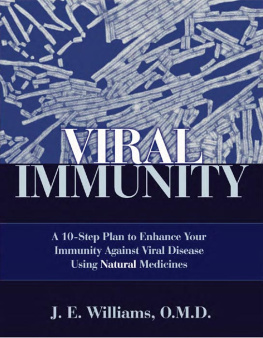HERBAL ANTIVIRALS
NATURAL REMEDIES FOR EMERGING AND RESISTANT VIRAL INFECTIONS
Ester Medicrone
Copyright 2020 by Ester Medicrone All rights reserved.
This eBook is provided with the sole purpose of providing relevant information on a specific topic for which every reasonable effort has been made to ensure that it is both accurate and reasonable. Nevertheless, by purchasing this eBook, you consent to the fact that the author, as well as the publisher, are in no way experts on the topics contained herein, regardless of any claims as such that may be made within. As such, any suggestions or recommendations that are made within are done so purely for entertainment value. It is recommended that you always consult a professional prior to undertaking any of the advice or techniques discussed within.
This is a legally binding declaration that is considered both valid and fair by both the Committee of Publishers Association and the American Bar Association and should be considered as legally binding within the United States.
The reproduction, transmission, and duplication of any of the content found herein, including any specific or extended information, will be done as an illegal act regardless of the end form the information ultimately takes. This includes copied versions of the work, both physical, digital, and audio unless express consent of the Publisher is provided beforehand. Any additional rights reserved.
Furthermore, the information that can be found within the pages described forthwith shall be considered both accurate and truthful when it comes to the recounting of facts. As such, any use, correct or incorrect, of the provided information will render the Publisher free of responsibility as to the actions taken outside of their direct purview. Regardless, there are zero scenarios where the original author or the Publisher can be deemed liable in any fashion for any damages or hardships that may result from any of the information discussed herein.
Additionally, the information in the following pages is intended only for informational purposes and should thus be thought of as universal. As befitting its nature, it is presented without assurance regarding its prolonged validity or interim quality. Trademarks that are mentioned are done without written consent and can in no way be considered an endorsement from the trademark holder.
Table of contenS
INTRODUCTION
Antiviral drugs are a class of drugs that are specifically used to treat viral infections and not bacterial infections. Most antivirals are used for certain viral infections, but broad-spectrum antivirals work against a wide range of viruses. In contrast to most antibiotics, antivirals do not destroy the target pathogen. Instead, they hinder their development.
"Antiviral drugs are drugs that reduce the ability of the influenza virus to reproduce."
The concept of herbal antibiotics as the primary intervention has been widespread in non-western developed cultures in recent decades. Health systems in Africa, Asia, South and Central America are avoiding medication as a primary treatment for bacterial infections due to resistance problems, mainly because pharmaceutical companies earn too much money from their suffering. Non-Western cultures recognize that they can no longer afford corporate greed and therefore, do not attempt to kill the poor of their people. Researchers from cultures around the world have found that herbal antimicrobials are often more effective than drugs.
EMERGING VIRUSES
Viral diseases caused by pathogenic viral infections with high morbidity and mortality are still the leading cause of death in humans worldwide. In addition, the appearance of virus resistance to the drug and the serious side effects caused by antiviral drugs have caused serious medical problems, especially when given in combination over a long period of treatment. And these drugs are very expensive and therefore limit their use in developing countries where infections are most common.
For most of the 20th century, infectious diseases declined in Western European populations because they learned to disinfect cities, clean water supplies, improve household hygiene, use antibiotics, control vector organisms, and vaccinate. As a result, the industrialized countries have become much more generous and have welcomed the wrong start of life with few infectious diseases. However, things have become much less certain since the 1980s, as many previously unidentified infections have occurred, and well-known infections that were considered to be under control have returned. This trend has continued to this day, and many infectious agents, especially viruses, have been newly identified.
In the summer of 2006, a little-known viral disease spread to large and diverse islands in the Indian Ocean. On Reunion Island, 265,000 of the 770,000 inhabitants were seriously ill. Very few were asymptomatic. The disease was severe in almost all cases. Healthcare workers and the island's hospital system were overwhelmed. Even if they weren't there, there was little they could do. So, they provided "support". In other words, they were watching. They waited. Human immunity and the body's system will either ward off them or not. This was not the case with many. The virus quickly jumped to India and killed an estimated 1.3 million people. Who's the culprit? Chikungunya fever, a relatively unknown viral disease. 1 This virus is known in medicine, but not very well. It is not a common illness. But it was mutated. The subsequent analysis showed that the mutation occurred between spring and autumn 2005. The area became pandemic within six months. By the end of 2006, more than 2 million people were infected. The disease is accompanied by severe joint pain (such as dengue fever). Ankles and wrists are most affected. Conjunctivitis and rashes are common. Cumulative injury can persist for weeks or months and is debilitating. There is no remedy or an antidote.
Doctors recommend the use of acetaminophen for pain. Causes of death of many people. Paracetamol damage to the liver. People who visited areas that returned to their home in the United States and Europe brought diseases. More than 1,000 people have been diagnosed in the United States. A large number of cases have led to the human-to-human transmission and infected new hosts. The disease is mainly transmitted by mosquitoes (like most diseases covered in this book), mainly Aedes aegypti. This is a mosquito that used to have a limited geographical area but has spread to all continents of the world in the past 50 years.
This is an example of how quickly new viral pathogens can spread to villages around the world. It started with the African virus entering Asian mosquitoes and travelling by plane and boat to the Indian Ocean and India. And from there it went everywhere. This dynamic is now developing all over the planet. Chikungunya is not uncommon. A pandemic caused the West Nile encephalitis virus in the United States in 1999. It soon spread around the world and is now common in Europe and Asia. In the fall of 2002, SARS appeared in China and quickly spread throughout Asia. Epidemiologists who investigated the SARS outbreak initially found that it had occurred in a small area of China. The sick doctor visited Hong Kong and infected 16 people. Some of them have travelled, which has spread the disease worldwide within a few weeks.
VIRUSES
Scientists generally believe that viruses do not live. Many claims that these are just organic structures that interact with living organisms. They say that they are "creatures on the edge of life", but they are not really meaningful creatures. This is because they say that they have no cell structure, do not have their own metabolism and can only regenerate within the cell structure. In addition, we do not do this with cell division.








